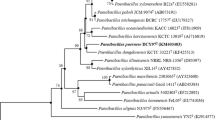Abstract
An extracellular protease-producing yeast strain, designated as CO-3, was isolated from fermented tea. The cells were spherical- to ovoid-shaped and 6.8–7.4×7.4–9.1 ώm in size. Optimal growth conditions were 25–30°C and pH of 5.0–6.0. The isolate was able to grow in up to 4%(w/v) NaCl and 5%(v/v) ethanol. This strain was identified as Sporidiobolus ruineniae based on the internal transcribed spacer regions including 5.8S rDNA sequence and partial D1/D2 domain of 26S rDNA sequence analysis. Optimal activity conditions of the crude protease fraction of S. ruineniae CO-3 were pH of 7.0 at 50°C. Protease production reached maximum when 1.0%(w/v) xylose, 1.0%(w/v) yeast extract, and 0.3%(w/v) K2HPO4 were used as the sole sources of carbon, nitrogen, and mineral, respectively.
Similar content being viewed by others
Abbreviations
- CMC:
-
carboxymethyl cellulose
- ITS:
-
internal transcribed spacer
- PCR:
-
Polymerase chain reaction
- TCA:
-
trichloroacetic acid
- YM:
-
yeast extract-malt extract
References ba]{au{fnAltschul} {gnSF}}, {au{fnMadden} {gnTL}}, {au{fnSchaffer} {gnAA}, {fnZhang} {gnJ}, {fnZhang} {gnZ}},
Miller W, and Lipman DJ (1997) Gapped BLAST and PSIBLAST: a new generation of protein database search programs. Nucleic Acids Res 25, 3389–3402.
Amoozegar MA, Fatemi AZ, Karbalaei-heidari HR, and Razavi MR (2006) Production of an extracellular alkaline metalloprotease from a newly isolated, moderately halophile, Salinivibrio sp. strain AF-2004. Microbiol Res 162, 369–377.
Barnett JA, Payne RW, and Yarrow D (2000) In Yeasts: Characteristics and identification, (3rd ed.), p. 1–1139. Cambridge University Press, Cambridge, UK.
Brizzio S, Turchetti B, de Garcia V, Libkind D, Buzzini P, and van Broock M (2007) Extracellulr enzymatic activities of basidiomycetous yeasts isolated from glacial and subglacial waters of northwest Patagonia (Argentina). Can J Microbiol 53, 519–525.
Buzzini P and Vaughan-Martini A (2006) Yeast biodiversity and biotechnology. In Yeast: Biodiversity and ecophysiology of yeasts, (Rosa CA and Peter G ed.), pp. 533–559. Springer-Verlag, Berlin.
Chi Z and Zhao S (2003) Optimization of medium and cultivation conditions for pullulan production by a new pullulan-producing yeast strain. Enzyme Microb Technol 33 206–211.
Chi Z, Ma C, Wang P, and Li HF (2007) Optimization of medium and cultivation conditions for alkaline protease production by the marine yeast Aureobasidium pullulans. Bioresour Technol 98, 534–538
Deshpande V (1998) Molecular and biotechnological aspects of microbial proteases. Microbiol Mol Biol Rev 62, 597–635.
Elad Y and Kapat A (1999) The role of Trichoderma harzianum protease in the biocontrol of Botrytis cinerea. Eur J Plant Pathol 105, 177–189.
Fell JW, Boekhout T, Fonseca A, Scorzetti G and Statzell-Tallman A (2000) Biodiversity and systematics of basidiomycetous yeasts as determined by large-subunit rDNA D1/D2 domain sequence analysis. Int J Syst Evol Microbiol 50, 1351–1371.
Felsenstein J (1985) Confidence limits on phylogenies: an approach using the bootstrap. Evolution 39, 783–791.
Griffin HL, Greene RV, and Cotta MA (1992) Isolation and characterization of an alkaline protease from the marine shipworm bacterium. Curr Microbiol 24, 111–117.
Hagihara B, Matsubara HI, Nakai M, and Okunuki K (1958) Crystalline bacterial protease: I. Preparation of crystalline protease of Bacillus subtilis. J Biochem 45, 185–194.
Kalisz HM (1988) Microbial proteinases. Adv Biochem Eng Biotechnol 36, 1–65.
Kamada M, Oda K, and Murao S (1972) Extracellular protease of yeasts. III. Purification of the extracellular acid protease of Rhodotorula glutinis K-24 and its general properties. Agric Biol Chem 36, 1095–1101.
Kurmar CG and Tagaki H (1999) Microbial alkaline protease: from bioindustrial viewpoint. Biotechnol Adv 17, 561–594.
Najafi MF, Deobagkar D, and Deobagkar D (2005) Potential application of protease isolated from Pseudomonas aeruginosa PD100. Electron J Biotechnol 8, 198–207.
Nelson G and Young TW (1987) Extracellular acid and alkaline proteases from Candida olea. J Gen Microbiol 133, 1461–1469.
Page RDM (1996) TREEVIEW: An application to display phylogenetic trees on personal computers. Comput Appl Biosci 12, 357–358.
Patel R, Dodia M, and Singh, SP (2005) Extracellular alkaline protease from a newly isolated haloalkaliphilic Bacillus sp.: production and optimization. Process Biochem 40, 3569–3575.
Rao MB, Tanksale AM, Ghatge MS, and Deshpande, VV (1998) Molecular and biotechnological aspects of microbial proteases. Microbiol Mol Biol Rev 62, 597–635.
Ray MK, Devi KU, Kumar GS, and Shivaji S (1992) Extracellular protease from the antarctic yeast Candida humicola. Appl Environ Microbiol 58, 1918–1923.
Ruchel R (1981) Properties of a purified Proteinase from the yeast Candida albicans. Biochim Biophys Acta 659, 99–113.
Strauss MLA, Jolly NP, Lambrechts MG, and van Resemburg P (2001) Screening for the production of extracellular hydrolytic enzymes by non-Saccharomyces wine yeasts. J Appl Microbiol 91, 182–190.
Thompson JD, Gibson TJ, Plewniak F, Jeanmougin F, and Higgins DG (1997) The ClustalX windows interface: flexible strategies for multiple sequence alignment aided by quality analysis tools. Nucleic Acids Res 24, 4876–4882.
White TJ, Brans T, Lee S, and Taylor JW (1990) Amplification and direct sequencing of fungal ribosomal RNA genes for phylogenetics. In PCR protocols: A guide to methods and applications, (Innis MA, Gelfand DH, Snissky JJ, and White TJ eds.), pp. 315–322. Academic Press Inc., New York, USA.
Yamada T and Ogrydziak DM (1983) Extracellular acid proteases produced by Saccharomycopsis lipolytica. J Bacteriol 154, 23–31.
Author information
Authors and Affiliations
Corresponding author
Rights and permissions
About this article
Cite this article
Kim, J.Y. Isolation of Sporidiobolus ruineniae CO-3 and Characterization of Its Extracellular Protease. J. Korean Soc. Appl. Biol. Chem. 52, 1–10 (2009). https://doi.org/10.3839/jksabc.2009.001
Received:
Accepted:
Issue Date:
DOI: https://doi.org/10.3839/jksabc.2009.001



